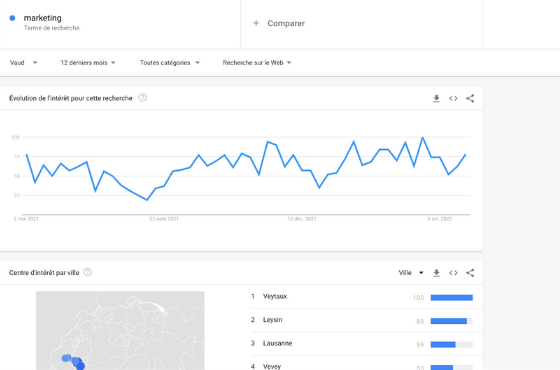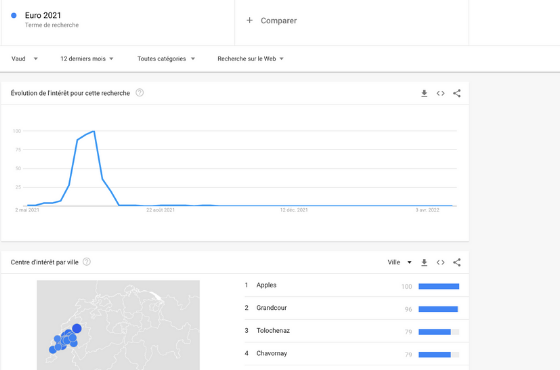It is important to understand search engine trends in order to build visibility for your site on search engines. Among many other details, trends show us how searches have evolved over the past few years based on a country or region and how Google views these topics. It is clear that some topics and information are more popular than others. But what do these search trends actually mean? This article will help you understand how search trends work and what they mean for your marketing strategy.
How to analyze the trends?
If you’re a marketer, you can use analytics tools to create content relevant to your audience. If you’re just curious, you can use them to find out what people are searching for.
Google search trends/trends help you understand the context of search queries over time. For example, if a lot of people search for “web designer,” the analytics tools will tell you exactly when people searched for it the most. They will also tell you how often that keyword was searched for compared to other keywords in the same category.
It’s also totally possible to compare multiple search terms or topics with each other to see which one is the most popular over time. For example, if I wanted to know how many people searched for “lobster” and “crab” last year at Christmas, I could compare those two terms to each other.
Why is it important to follow trends?
Trend analysis tools can be extremely useful if you want to know how your competitors are performing, how popular your products are and how they compare to your competitors, and even what keywords your customers are using when they search for the type of products you sell.
Google Trends can therefore offer useful information about the marketing industry. For example, if you’re a retailer looking to launch a new product, Google Trends can help you decide how to target and price it. If a search term for your product is highly seasonal, for example, you’ll know you need to book your biggest advertising campaign for that time of year. Or if a related product has grown significantly in popularity in recent years, you may want to consider lowering the price of your offering to better compete.
If you’re trying to predict future trends in your industry as a whole, Google Trends can also be helpful. By looking at what people are currently searching for and how those searches have changed over time, you can spot patterns that may indicate future developments. If a certain type of product is gaining popularity while another is declining, it could indicate that consumer tastes are changing in a way that would affect sales of both products in the future.
Research trends in Switzerland
To illustrate our article, here is an example of trends in Switzerland in 2021 according to different categories according to Google:
The trends are translated directly from German.
-
Trends of the year
- Euro 2021
- Coronavirus Suisse
- Champions League
- Roland Garros
- SRF Tippspiel
-
The what/which questions
- What will I cook today?
- What should I do if I have cystitis?
- What is Pentecost?
- What is a Covid certificate?
- What is a mellotron?
-
Headlines
- Christian Eriksen
- Switzerland France
- Covid Certificate
- WhatsApp failure
- Suez Canal
-
How much/what questions
- How long is a PCR test valid?
- How many cantons are there in Switzerland?
- How many cantons are there in Switzerland?
- How many people live in Switzerland?
- How many people live in Switzerland?
What are the explanations for these trends?
The data from these analytics tools is based on Google’s search activity, so it can be influenced by many factors.
Search activity consists of two main elements:
- The frequency with which people search for a particular term or topic.
- The total number of searches performed on Google during a given period.
The first component reflects the popularity of a specific topic at a given time. For example, interest in a certain type of car or soccer team may increase at certain times of the year (e.g., during major events such as the world championships).
The second component measures the total volume of searches performed on Google as a whole. The higher the overall search volume, the easier it will be for a given term or topic to reach high levels of popularity, even if its popularity has not increased relative to other topics.
It is possible to do very precise research on trends using different tools.
For example, here is the evolution of searches over the last 12 months in the canton of Vaud for the term “Marketing”. Being a generic term, the variations are not too important.

On the other hand, for a product or a word linked to a season or a period of the year, the variations can be important. Here, we have for example the evolution of the searches for Euro 2021 in the canton of Vaud these last 12 months.

Optimize trends for your business
These tools are powerful for understanding your customer base and making strategic decisions about new product development, marketing strategies or supplier relationships. Like any other tool, you need to know how to use them and our SEO experts can help you analyze your data.
Here are some tips on how to make the most of these tools for your business:
- Read the data well. If you’re measuring the performance of your ad as part of a campaign, make sure you’re using impressions, otherwise you risk getting skewed results.
- Tailor your keywords. The more specific your search query, the more detailed and accurate your results will be.
- Determine which data points are most important to your business. Think about your goals and look at how the data affects them.
Habefast's expertise
Our digital agency Habefast helps you to optimize your SEO and digital visibility that fits perfectly with your overall marketing strategy. Our team of SEO and conversion experts will be happy to help you create or develop your online presence to increase your visibility and get the best possible results.

